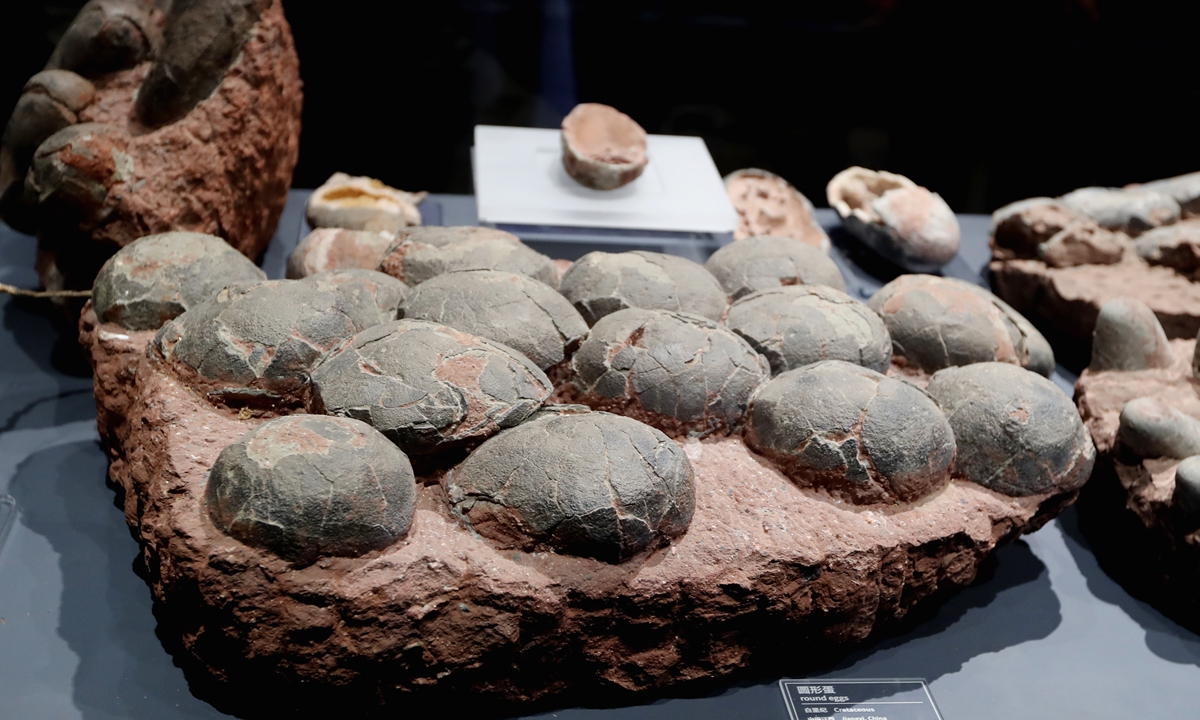
Dinosaur egg fossils preserved at Chengjiang Fossil Site Natural History Museum in Yuxi city, Southwest China's Yunnan Province Photo: IC
Chinese scientists have discovered that a sustained decline in dinosaur diversity happened in the Late Cretaceous period by carrying out studies on dinosaur egg fossils.
They concluded that such decline weakened the dinosaurs' ability to adapt to environmental upheavals derived from major natural disasters which eventually caused their extinction.
Scientists have never stopped seeking the reason for the disappearance of dinosaurs, one of the most fascinating paleontological species to the public. These animals appeared in the Late Triassic Epoch, 235 million years ago, and lived on earth for as long as 170 million years but disappeared 66 million years ago.
The most prominent of the various hypotheses about the extinction of the dinosaurs include extraterrestrial factors, such as one involving the asteroid impact, as well as terrestrial factors, such as the massive volcanic eruptions in India's Deccan Traps. All these hypotheses are related to major geological events.
Meanwhile, since dinosaurs were oviparous animals and the success of hatching eggs directly determined the prosperity of dinosaur populations, researches on dinosaur eggs, the major carrier of dinosaurs to thrive on the earth, can reflect the information of the paleoenvironment where the dinosaurs lived.
A series of scientific researches on dinosaur eggs and the strata in Shanyang Basin in Northwest China's Shaanxi Province carried out by Chinese scientists have provided a new understanding for the mystery of the extinction of dinosaurs.
The research team collected over 1,000 specimens of dinosaur eggs and eggshells of three species buried in situ in the Late Cretaceous section in Shanyang Basin. The dinosaur eggs and a small amount of dinosaur bones collected in the region show that the diversity of the dinosaurs in the basin then was at a relatively low level.
Combined with the researches on the geological age of the strata in Shanyang Basin through magnetostratigraphy, biostratigraphy and cyclic stratigraphy, researchers found that dinosaur fossils date back between 68.24 million and 66.38 million years ago, which means the diversity of the dinosaurs in the basin remained relatively low during a 2-million-year period before their extinction.
Researchers also found that the diversity of dinosaurs had an apparent declining trend around 72 million years ago, based on the dinosaur fossils found during the Late Cretaceous period in the eastern area to Qinling mountains, Northwest China's Shaanxi Province, Laiyang in East China's Shandong Province and Nanxiong in South China's Guangdong Province.
That shares similarities with the distribution of dinosaur fossils in the western part of North America. Therefore, the researchers think that the decline in dinosaur diversity during the Late Cretaceous was probably a global phenomenon.
The research conducted by scientists from the Institute of Vertebrate Paleontology and Paleoanthropology and the Institute of Geology and Geophysics under the Chinese Academy of Sciences, and China University of Geosciences, Wuhan, provides a new basis and perspective for people to understand the extinction process and mechanism of dinosaurs. The research was also recently published as a cover story in the international academic journal Proceedings of the National Academy of Sciences (PNAS).
Global Times




